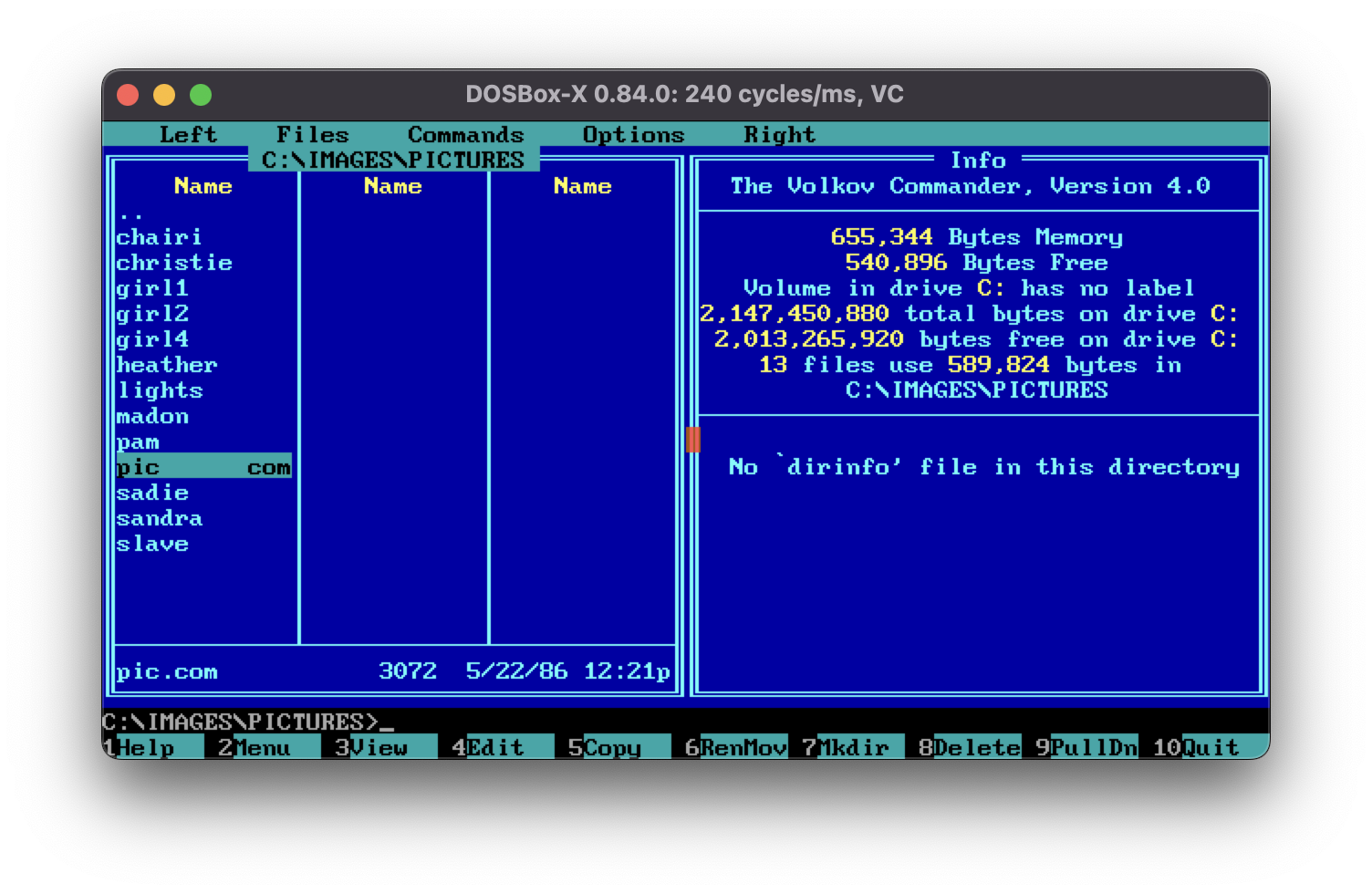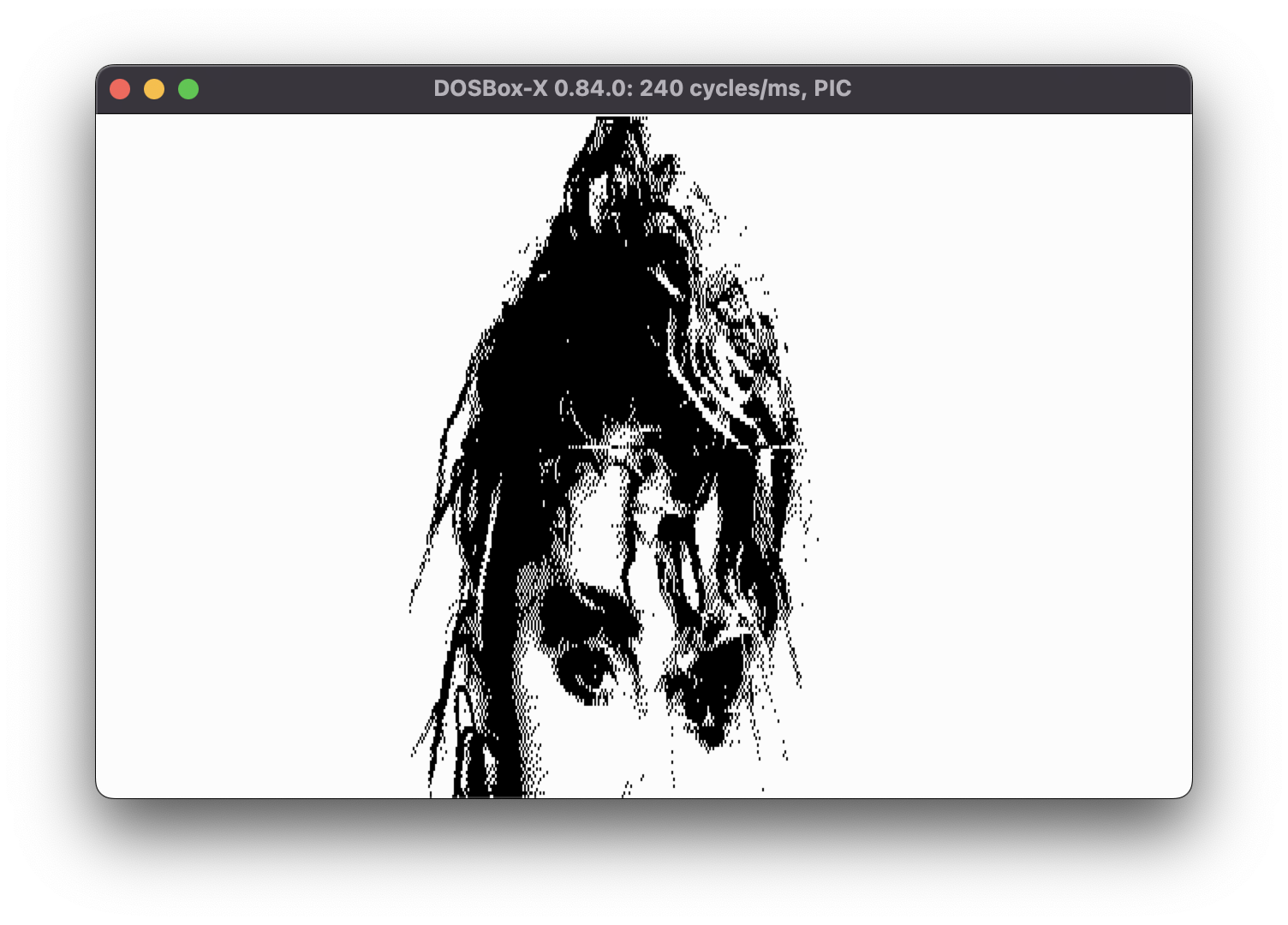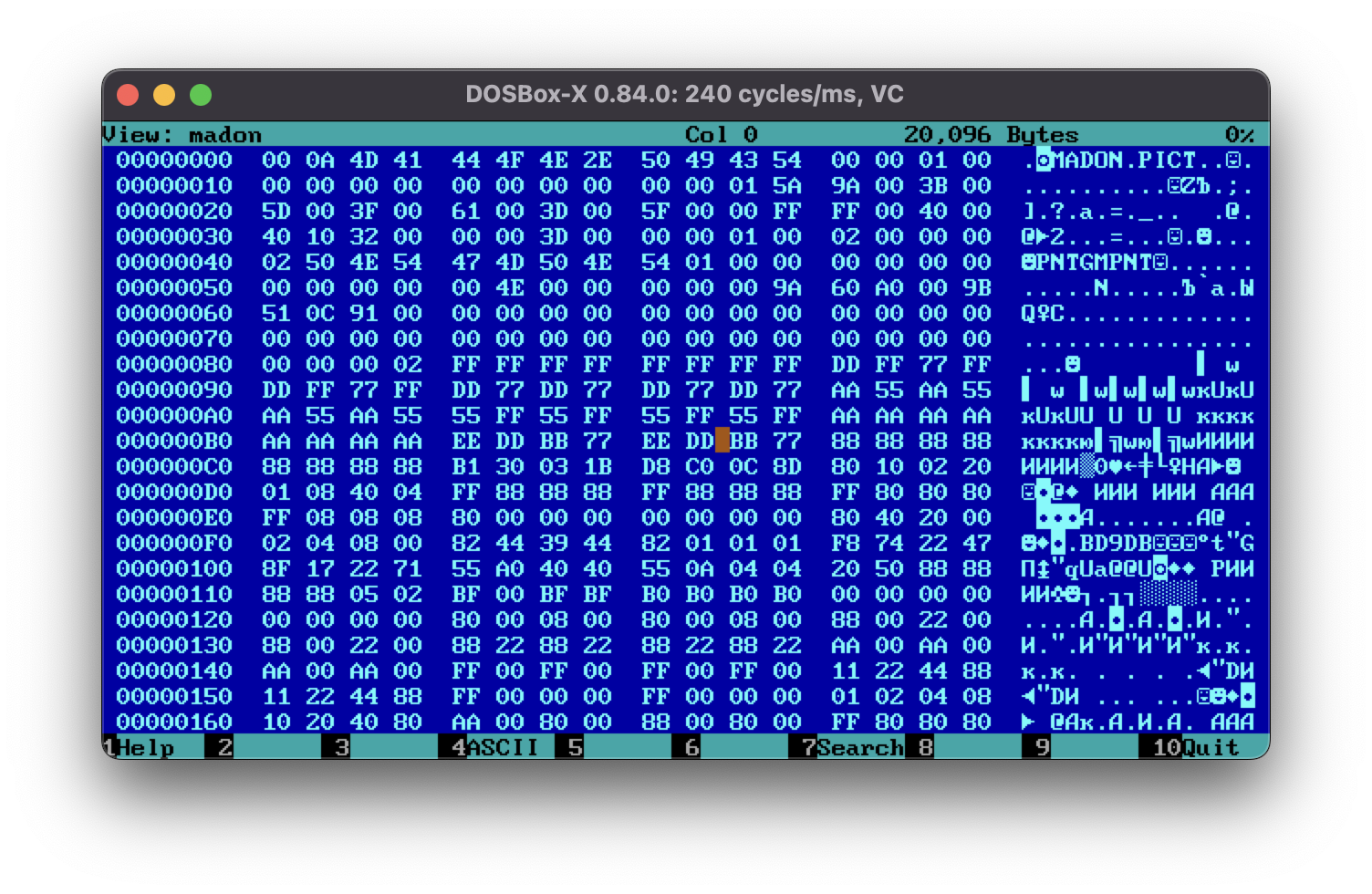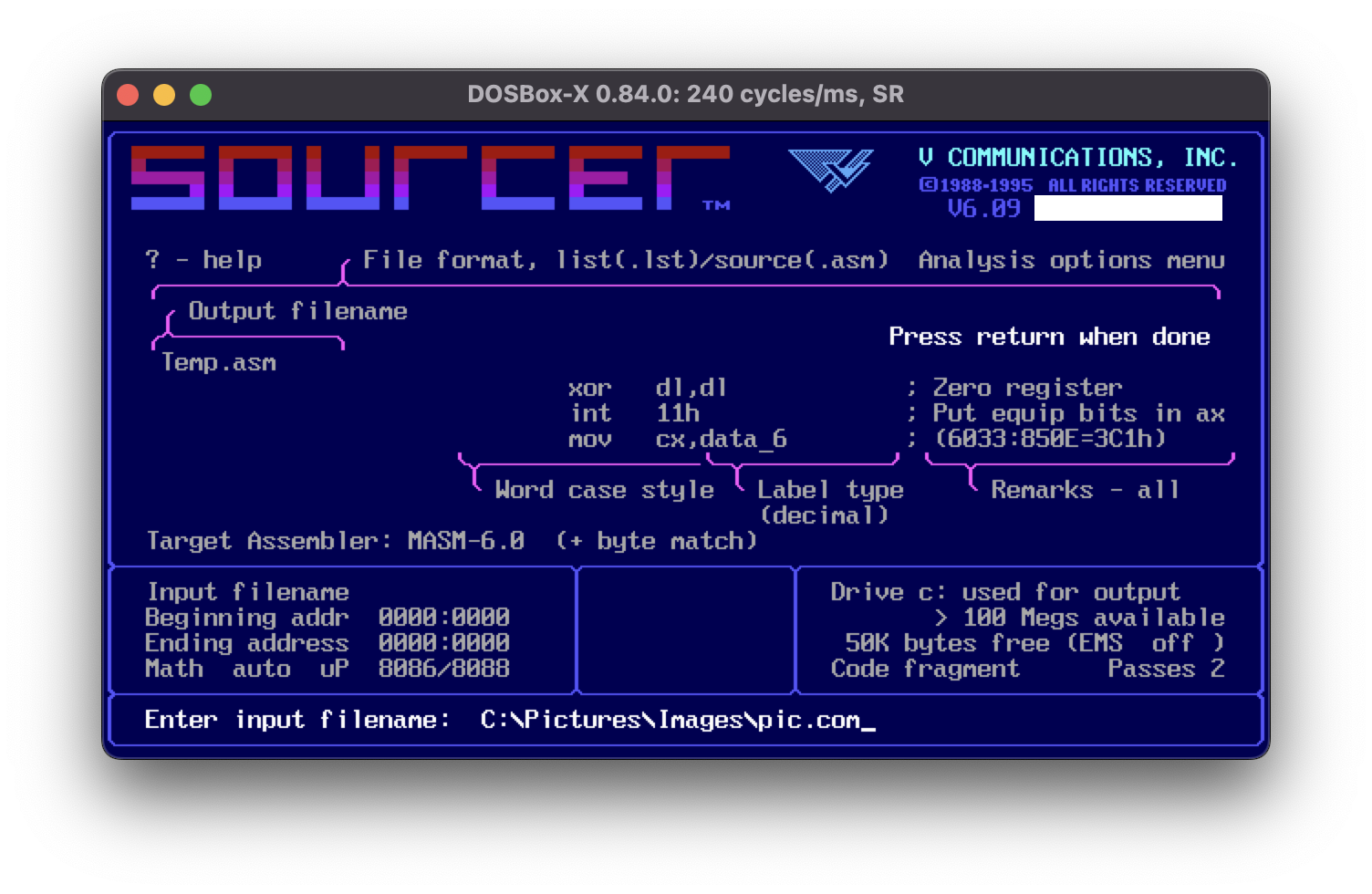And just when I thought I was done with converting old images into BMP format … another picture format attracted my curiosity.
For fun, read my previous post about decoding old-school SCR Images
Background
Looks like I have found a program that was used to print posters (maybe?). This program came with number of images in the package:
 When ran,
When ran, PIC.COM shows the following screen. We can type the file name we want to open:
 And, when opening the
And, when opening the MADON file, we see a “Madonna” poster:
 Using the arrow keys we can scroll the view up and get more details of the poster. Which means the image is larger than the actual view port.
Using the arrow keys we can scroll the view up and get more details of the poster. Which means the image is larger than the actual view port.
The program also seems to use 640x200 resolution. As a reminder, this resolution sports a whopping 1 bpp with only black and white colors.
The file structure
Following the existing procedure, let’s see what the file format is. To achieve that we need to see its hex view:
 Hm, interesting. This file seems to actually have a header. That might make the decoding a bit more complicated as this means that the header might contain image data size or any other meta information required to decode it. Also the file sizes are all different which, can point to a compression format.
Hm, interesting. This file seems to actually have a header. That might make the decoding a bit more complicated as this means that the header might contain image data size or any other meta information required to decode it. Also the file sizes are all different which, can point to a compression format.
Reversing the executable
To be honest I have no idea how to approach this format and I the most reasonable way of proceeding would be to study the source code of the PIC.COM utility.
To achieve that, I have the amazing DOS program called Sourcer which I found lying around my DOS-era archives:

In the above screenshot, we select the output format of the dec-compiled source as MASM-compatible assembly language and select the input file.
As side note, check out the cool UX that this program sports. I just love it!
The output of running Sourcer is a nice PIC.ASM file that has been annotated and ready to be looked at. Here is a small snippet:
;��������������������������������������������������������������������������
;
; External Entry Point
;
;��������������������������������������������������������������������������
real_start:
push ax
push bx
push cx
push dx
push si
push di
push ds
push es
push cs
pop ds
call sub_11
lea bx,cs:[0BE3h] ; Load effective addr
mov cs:image_buffer_ptr,bx
loc_1:
mov ax,3
int 10h ; Video display ah=functn 00h
; set display mode in al
mov ax,600h
mov bh,7
mov cx,0
mov dx,184Fh
int 10h ; Video display ah=functn 06h
; scroll up, al=lines
; bh=attrib, cx+dx=window size
lea dx,data_8 ; ('') Load effective addr
mov ah,9
int 21h ; DOS Services ah=function 09h
; display char string at ds:dx
lea dx,data_15 ; Load effective addr
mov ah,0Ah
int 21h ; DOS Services ah=function 0Ah
; get keybd line, put at ds:dx
mov al,cs:data_16
mov ah,0
mov si,ax
mov cs:data_17[si],0
mov byte ptr cs:data_14[si],24h ; '$'
mov cx,si
mov si,zero
The rendering process
Note how Sourcer has named the memory locations using data_xx names. That’s to be expected since we do not have debug symbols and the de-compiler simply attributed random names to each memory location and sub-routine.
This means that the only way to understand the actual code is to look at it, and replace these auto-generated names with the actual names as we go along.
My process is simple. when I understand the purpose of a memory location/variable/sub-routine, I simply replace that name with something more readable based on its purpose.
But, first things first, where is the sub-routine that draws on the screen? The way to approach that is to find the code that references the CGA video memory segment 0xb800. Searching the file we immediately find the following sub-routine:
sub_7 proc near
push ax
push bx
push cx
push dx
push si
push di
push bp
push es
mov ax,0B800h ; <------ CGA VIDEO MEMORY REFERENCE
mov es,ax
mov bp,data_51e
mov ax,cs:data_38
mov si,48h
mul si ; dx:ax = reg * ax
add ax,cs:data_37
mov bx,ax
mov cx,64h
locloop_57:
push cx
mov si,data_1e
mov di,data_51e
mov cx,48h
locloop_58:
mov al,[bx+si]
xor al,0FFh
mov es:[bp+di],al
inc si
inc di
loop locloop_58 ; Loop if cx > 0
add bx,data_7e
add bp,50h
pop cx
loop locloop_57 ; Loop if cx > 0
mov bp,data_52e
mov ax,cs:data_38
mov si,48h
mul si ; dx:ax = reg * ax
add ax,cs:data_37
mov bx,ax
add bx,48h
mov cx,64h
locloop_59:
push cx
mov si,data_1e
mov di,data_51e
mov cx,48h
locloop_60:
mov al,[bx+si]
xor al,0FFh
mov es:[bp+di],al
inc si
inc di
loop locloop_60 ; Loop if cx > 0
add bx,90h
add bp,50h
pop cx
loop locloop_59 ; Loop if cx > 0
pop es
pop bp
pop di
pop si
pop dx
pop cx
pop bx
pop ax
retn
sub_7 endp
We can separate this sub-routine into two parts:
- From the
mov ax,0B800htoloop locloop_57, the code draws the picture into the first page of the CGA video memory, - And from
mov bp,data_52etoloop locloop_59, the second page. The value ofdata_52eis0x2000.
For each page it looks as there are two loops. I won’t try to go through each line of the assembly, though as there’s too much to follow. Instead, here’s the pseudo-C code of this function:
int video_memory = 0xb800 // first memory page at 0xb800
for (row = 0; row < 200; row += 2) {
for (col = 0; col < 72; col++) {
int pix8 = image_bytes[scroll_index + (row * 80) + col] ^ 0xff
video_memory[row * 80 + col] = pix8
}
}
video_memory = video_memory + 0x2000 // next memory page
for (row = 1; row < 200; row += 2) {
for (col = 0; col < 72; col++) {
int pix8 = image_bytes[scroll_index + (row * 80) + col] ^ 0xff
video_memory[row * 80 + col] = pix8
}
}
Right, so what’s with all these magic numbers: 72 (0x48), 200 (0x64 * 2), 80 (0x50) and why are we XOR-ing with 0xff? Remember that each row is 640 pixels? That translates to 640 pixels / 8 ppb = 80 bytes. But why are we only copying 72 bytes into the video memory? Well that’s up to the original developer; apparently the width of these images is 72 bytes * 8 bpp = 576 pixels. The height of the same video mode is 200 pixels which explains the loops.
The file format
Since we have identified the rendering function, now we need to figure out what is the actual file format. In the previous section, the memory at data_37 is the actual raw image bytes which are being copied into the video memory. The data_38 is the vertical offset in the image to copy into the video memory (remember, one can scroll up and down using arrow keys).
Looking further into the source code there’s a few sub-routines that stand out:
sub_9 proc near
push dx
lea dx,data_17 ; Load effective addr
mov ax,3D00h
int 21h ; DOS Services ah=function 3Dh
; open file, al=mode,name@ds:dx
mov cs:data_18,ax
pop dx
retn
sub_9 endp
This one seems to open the input file and store the handle into data_18 memory location. Following that variable we find:
sub_10 proc near
push bx
push cx
push dx
mov ah,3Fh ; '?'
lea dx,data_19 ; Load effective addr
mov cx,80h
mov bx,cs:data_18
int 21h ; DOS Services ah=function 3Fh
; read file, bx=file handle
; cx=bytes to ds:dx buffer
mov cs:data_35,0
pop dx
pop cx
pop bx
retn
sub_10 endp
This one seems to read 128 (0x80) bytes from the input file into data_19 memory location; and resets another memory location at data_35 to 0. Let’s follow the thread further:
sub_8 proc near
push si
mov si,cs:data_35
cmp si,80h
jl loc_61 ; Jump if <
call sub_10
mov si,data_1e
loc_61:
mov al,cs:data_19[si]
inc cs:data_35
pop si
retn
sub_8 endp
Alright, here they seem to be returning a byte from the buffer filled in by sub_10. If the read byte exceeds 128 (0x80), this sub-routine calls the aforementioned sub_10 to load more bytes. This explains why data_35 is set to zero in sub_10. It’s basically an index into the buffer which needs to be refilled at each 128 bytes.
It makes sense to find the uses of sub_8 and sub_10. The following code is found at some point when the name of the file is entered by the user:
lea dx,data_12 ; ('') Load effective addr
mov ah,9
int 21h ; DOS Services ah=function 09h
; display char string at ds:dx
call sub_9
jnc loc_3 ; Jump if carry=0
lea dx,data_13 ; ('') Load effective addr
mov ah,9
int 21h ; DOS Services ah=function 09h
; display char string at ds:dx
jmp loc_25
loc_3:
call sub_2
mov cx,5
locloop_4:
call sub_10
loop locloop_4 ; Loop if cx > 0
This code calls sub_9 which opens the file and stores the handle, then, it calls sub_2 and then, calls sub_10 5 times in a loop. sub_2 seems to simply clean up the memory location where the image contents will be loaded and sub_10 called 5 time will basically skip the first 4 * 128 = 512 bytes. Looking at the hex view again, it seems that it might correspond to the header part of the file:
 This seems to indicate that
This seems to indicate that PIC.COM simply ignores the header!
The following piece of code finally reveals the last piece of the puzzle (cleaned for clarity):
mov cs:data_35,80h
mov cx,2D0h
mov bx,cs:data_37
locloop_5:
mov si,0
mov cs:data_34,0
push cx
loc_6:
call sub_8
cmp al,0
jl loc_8 ; Jump if <
mov ah,0
mov cx,ax
inc cx
locloop_7:
inc cs:data_34
call sub_8
mov [bx+si],al
inc si
loop locloop_7 ; Loop if cx > 0
jmp short loc_10
db 90h
loc_8:
mov cl,al
mov ch,0
mov ax,100h
sub ax,cx
mov cx,ax
inc cx
call sub_8
locloop_9:
inc cs:data_34
mov [bx+si],al
inc si
loop locloop_9 ; Loop if cx > 0
loc_10:
mov ax,cs:data_34
cmp ax,48h
jl loc_6 ; Jump if <
pop cx
add bx,48h
loop locloop_5 ; Loop if cx > 0
The pseudo-C version of this code is:
for (int row = 0; row < 720; row++) {
int col = 0;
while (col < 72) {
int count = read_next_image_byte()
if (count < 0) {
// if count is negative, transform to positive and assume the next
// byte repeats these many time plus one.
count = -count
int value = read_next_image_byte()
while (count >= 0) {
image_bytes[row * 72 + col] = value
col++
}
} else {
// if the count is positive, read said amount of following bytes plus one from the file.
while (count >= 0) {
image_bytes[row * 72 + col] = read_next_image_byte()
col++
}
}
}
}
Oh well, look at that. Another RLE decoder. Seems to decode each row of 72 bytes individually and assumes that there are always 720 rows.
Show me the code!
Alright, enough research, let’s write that python code again. I have actually reused much of the existing code used in the previous decoding attempt so this one will be easier to carry out.
First, the *RLE decoder:
def _expand_comp_rle(input: bytes, start: int, row_len: int) -> bytearray:
i=start
output=bytearray()
row=bytearray()
while i <len(input):
if len(row) >= row_len:
output.extend(row)
row.clear()
cmd=input[i]
repeats=(cmd & 0x80) == 0x80
if repeats:
count=0x100-cmd
else:
count=cmd
count +=1
i+=1
if repeats:
if i == len(input):
_logger.warning(f"Encountered a repeat command for {count} at {hex(i - 1)} at EOF. Assuming 0x00.")
rep=0
else:
rep=input[i]
row.extend([rep]*count)
i+=1
else:
row.extend(input[i:i+count])
i+=count
if len(row):
output.extend(row)
return output
This is the same code as the pseudo-C above. The start and row_len are used to control the decoding part (maybe will use in the future). The count=0x100-cmd line is equivalent to count=-count.
Now, the code that actually pulls things together follows as:
def _process_pic(raw: bytes, width: int, height: int, bpp: int, palette: dict[int, int]) -> np.ndarray:
pages=(bytearray(), bytearray())
HEADER=0x80*5
ROWS=720
COLS=72
raw=_expand_comp_rle(raw, HEADER, COLS)
for row in range(ROWS):
page=pages[row%2]
for col in range(COLS):
byte_index=row*COLS+col
if byte_index >= len(raw):
break
col_byte=raw[byte_index]^0xff
page.append(col_byte)
_pad_buffer(pages[0], 0x2000)
_pad_buffer(pages[1], 0x2000)
mode=CGA_modes['CGA6']
return _render(pages, COLS * 8, ROWS, mode['bpp'], mode['palette'])
And, finally, just in the previous blog post, we can simply export the 2D ndarray to a bitmap:

Disclaimer
It actually took me a good few hours while on a long cross-Atlantic flight to figure out the
PIC.COMcode and reinterpret it as python code.
Hope you enjoyed the post, Cheerios!